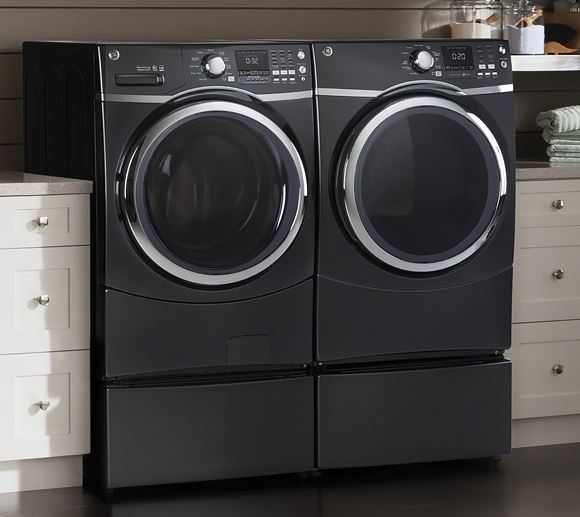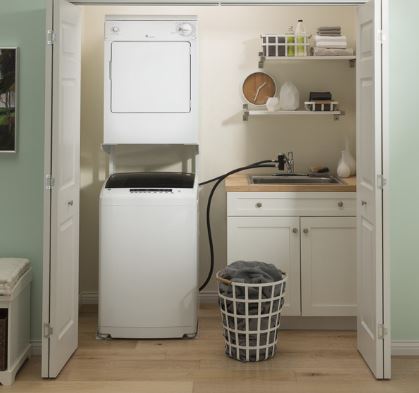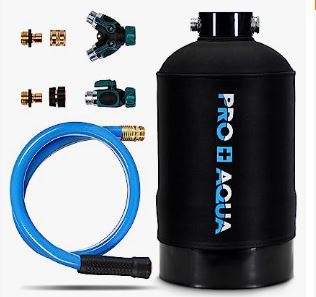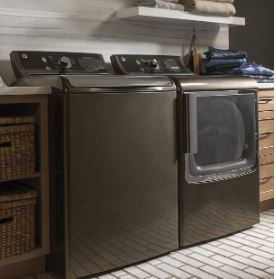Nothing annoys like a washer that completes the spin cycle only to leave the clothes soaking wet. That could happen to any washer, and if you have a GE type, you should quickly identify the reasons for a GE washer not spinning clothes dry.
Ordinarily, a GE washer won’t spin clothes dry due to a failed power supply, slow spin setting, washer imbalance, laundry overload, excess suds, poor drainage, hard water use, faulty drive belt, damaged lid switch or door lock, or a malfunctioning water-level control switch.
So, consider all these ten reasons if you ever want your GE washer to start spinning the clothes dry. As you’ll see, all the issues have fixes and are all DIY.
Remember, your GE washer spin must dry the clothes for two reasons. One is to ensure that the clothes come out spotless, and the other is to dry much faster when you load them into the dryer or air-dry them.
Let’s discuss the ten issues and their troubleshooting!

In a rush? Then, consider the quick troubleshooting guide below.
GE Washer Not Spinning Clothes Dry – Quick Troubleshooting Guide
| – | Likely Reason | Quick Fix |
| 1. | Failed Power Supply | Ensure the power plug is firmly plugged into the wall – not the extension cord. |
| 2. | Slow Spin Setting | Increase the spin speed (choose the correct spin setting) |
| 3. | Washer Imbalance | Ensure the washer is well balanced and evenly distribute the laundry. |
| 4. | Laundry Overload | Reduce the load – keep the drum capacity ¾ full. |
| 5. | Excess Suds | Use the correct detergent in the right amount. |
| 6 | Poor Drainage | Clean the drain filter, drain hose, and drain pump, clear kinks from the drain hose, and position the drain hose correctly (23-35 inches off the ground) |
| 7. | Hard Water Use | Soften the hard water, preferably with a water softener. |
| 8. | Faulty Drive Belt | Replace a worn-out or stretched drive belt. |
| 9. | Damaged Lid Switch or Door Lock | Replace the lid switch or door lock. |
| 10. | Malfunctioning Water-Level Control Switch | Replace the water-level control switch. |
Why Is My GE Washer Not Spinning Clothes Dry?
There are different reasons why a GE washing machine won’t spin clothes dry, and the commonest ones are as follows:
1. Failed Power Supply
Your GE washer won’t spin if there’s a power disruption. That could happen if the power cord is loosely plugged or if you plug it into the extension cord, not the wall socket. In both cases, your washer may fail to receive adequate power and will not spin dry the clothes.
Fix
Check the power plug and fix it firmly to the wall socket if it’s loose. Remember, you shouldn’t plug into the extension cord but the wall outlet.
2. Slow Spin Setting
If your washer is on a no-spin or slow-spin setting, it may not spin dry the clothes. For it to do so, its spin setting should be a little higher to allow it to turn fast.
Fix
Adjust the spin setting to ensure the washer spins at a much faster pace. Just ensure you choose the right spin setting for your washing machine.
3. Washer Imbalance
If your GE washer is out of balance, the clothes will also be out of balance and will, therefore, fail to spin smoothly. In that case, the clothes will form heaps, which will come out wet after the end of the spin cycle.
Fix
Adjust the washer’s feet if they are out of level to balance the washer. It may also help to move the washer to a more leveled surface and balance the load.

4. Laundry Overload
If you overfill the washer, the chances are that the load won’t turn properly or may fail to turn at all. In that case, you cannot expect the clothes to spin dry as they will likely be soaking wet.
Ideally, you shouldn’t fill the drum more than ¾ its capacity. The extra space is necessary for the clothes to turn and spin dry.
Fix
Reduce the excess load and keep the drum ¾ full. While at it, ensure you evenly balance the load before restarting the washer.
5. Excess Suds
The problem with excess suds is that they tend to keep the laundry wet even after the spin cycle. That could happen either from using the wrong detergent (which, in most cases, is a non-high-efficiency option) or overusing the correct detergent.
Fix
If your washer forms excess suds, check if you use the correct detergent (HE). If the detergent is the right type, don’t apply too much, as that could also cause too many suds.
6. Poor Drainage
If the washer doesn’t drain properly, you can expect some of the water to remain in the tub, and if so, the clothes will soak wet even after the spin cycle. If that’s the case, it could be due to any of these issues:
- Clogged drain filter
- Clogged or kinked drain hose
- Wrong drain hose position (lower than 23 inches off the ground)
- Clogged or defective drain pump
Fix
Properly clean the drain filter, hose, and pump if any of the three are clogged. If the hose is kinked, flatten it out and replace a damaged drain pump.
Meanwhile, maintain the correct drain pipe height, usually 23-35 inches off the ground.
7. Use of Hard Water
Hard water refers to water with excess hard minerals like calcium and magnesium, which makes it harder to lather. So, you will likely use a lot of detergent, which may interfere with the drainage and cause the clothes to take in more water.
In the long run, the clothes will come out wet after the spin cycle. The minerals may sometimes interfere with the washer’s spin cycle.
Overall, you can know if you are using hard water by observing most of these signs:
- Scale or chalk buildup around the washer and other fixtures
- Stains on clothes
- Spots on dishes
- Difficulty in lathering
Alternatively, employ a home water test kit (View on Amazon) to determine the water hardness level. In addition, the test kit can tell you the level of impurity, which is critical to determining if the water is safe for consumption.
Fix
If you are using hard water, consider softening it. One way to do it is by boiling it, which can be laborious and costly. Alternatively, you can install a water softener (View on Amazon) to soften your household water.

8. Faulty Drive Belt
If the drive belt is torn or stretched, it won’t run the drum as it should, affecting the spin cycle. In that case, the drum won’t turn as it should, and the washer may fail to spin dry the clothes.
Fix
Inspect the drive belt for signs of fault and replace it if that’s the case.
9. Damaged Lid Switch or Door Lock
If there’s an issue with the lid switch, the lid won’t shut properly (as with top loaders). Likewise, if there’s an issue with the door lock, the door won’t latch properly (as with the front loader).
In both cases, the washer will fail to complete the spin cycle when it notices that the lid or door is open, which may lead to soaking clothes.
Fix
If the lid of your GE top loader won’t close firmly, inspect the lid switch for damage and replace it if that’s so. Similarly, if the door of your GE front loader won’t latch, check the door lock for wear and replace it if that’s so.
10. Malfunctioning Water-Level Control Switch
Lastly, consider that your GE washer might not be spin-drying your clothes because the water-level control switch is malfunctioning. This switch regulates the amount of water the washer adds to the load, and once it starts to malfunction, it may lead to the washer adding more water than it should, which will cause the clothes to come out soaking wet.
Fix
Test the water-level switch with a multimeter to determine if it has continuity. If it doesn’t, as evidence of its defectiveness, replace it.
GE Front Load Washer Not Spinning Clothes Dry
If your GE front load washer won’t spin clothes dry, the first thing to check is the power cord and the setting. The washer should be firmly plugged in, and you should use a high spin setting.
Then check the washer to ensure it’s well balanced and the load to ensure it’s not overloaded. It’s also imperative to check the door and replace the door lock if it’s faulty.
Other checks include the detergent (which you shouldn’t overuse), the drainage (to ensure the water drains), and the water type (to soften it if it’s hard water).
And if the drive belt or water-level control switch is defective, replace it.
Troubleshooting GE Top Load Washer Not Spinning Clothes Dry
In the case of a GE top load washer that won’t spin, these troubleshooting tips are essential:
- Firmly plug the washer into the wall socket
- Choose a high-spin setting
- Reduce detergent overuse and ensure you use the correct detergent
- Balance the washer and the load
- Don’t overload the washer
- Replace a defective lid switch or drive belt

People Also Ask
1. What Would Cause a Washer Not to Spin Dry?
Different issues could stop a washer from spin-drying. The commonest ones include a loosely plugged power cord, a slow spin setting, an out-of-balance or overfilled washer, or poor drainage. But still, you’ve to consider possible excess suds, the use of hard water, a defective lid switch or door lock, or a malfunctioning water-level control switch.
2. Why Are My Clothes Still Wet After the Spin Cycle?
Your clothes are still wet after the spin cycle because the washer is loosely plugged into the wall, you are using a slow spin setting, the washer is out of balance or overloaded, or the water won’t drain. It could also be that you are using too much detergent or hard water, or one of the components is faulty, such as the drive belt, water-level control switch, lid switch, or door lock.
3. Will Clothes Dry Without a Spin Cycle?
Yes, clothes can dry without the spin cycle. After all, they’ll still dry if you wash them by hand and air-dry them or put them in the dryer. The difference is that they’ll take much longer to dry as they’ll come out of the washer soaking wet. Therefore, it’s advisable to use the spin cycle to shorten the dry time and ensure the clothes come out spotless.
Concluding Thought:
Now you know the ten issues behind a GE washer not spinning clothes dry. Remember, it takes one of these issues to stop your washer from spinning your clothes dry. The good news, however, is that you can troubleshoot them all DIY, and the above guide should get you started. It’s after you cannot do it DIY should you involve an expert – at least to save time and money!
Also Read:
